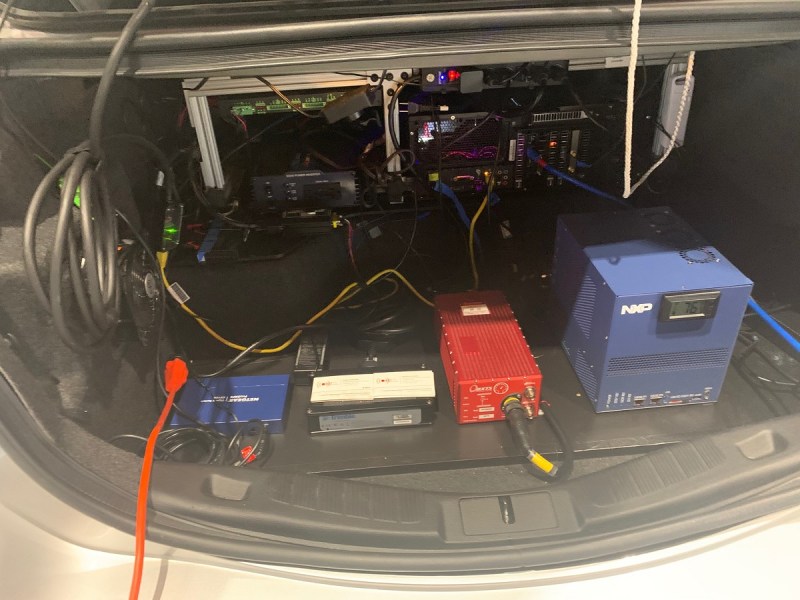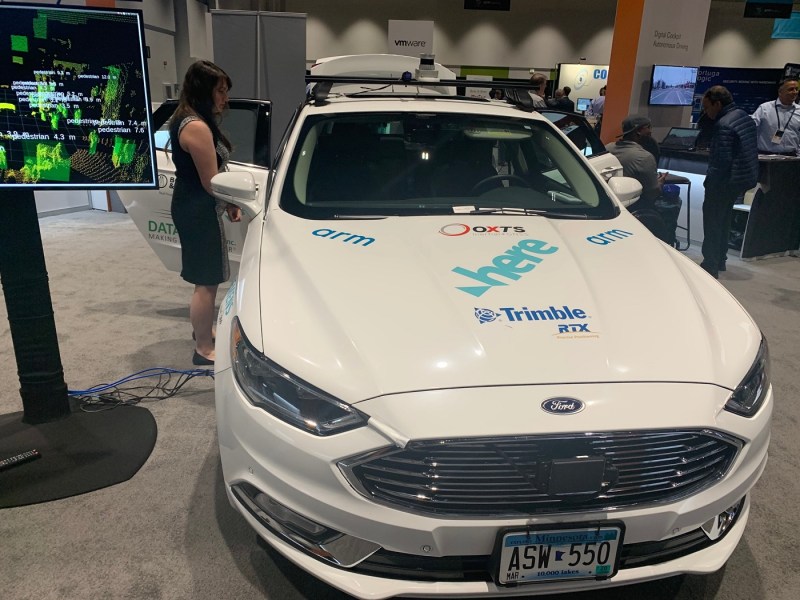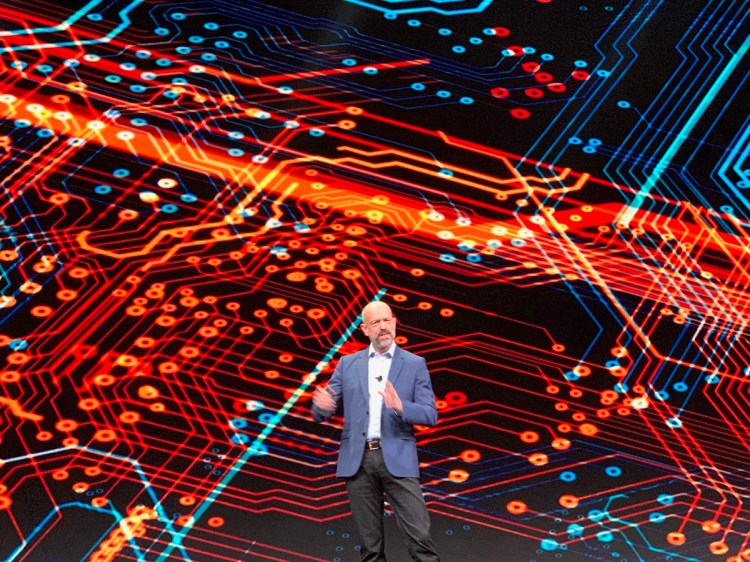
Above: Yep, it’s like a supercomputer in this self-driving car. VSI Labs’ full stack of AV technology in the trunk of their research vehicle.
Question: It seems like a big buzzword these days is heterogeneous computing. Clearly you’re invested in this idea that as Moore’s law slows down, people are going to use more of these different strategies to squeeze out more computing power at a certain workload capacity. Does that mean that you need to cooperate more with people who might traditionally have been competitors? Do you see more partnerships in the future? People are using totally different types of things to build devices. Does there need to be more collaboration?
Segars: I’m certain that solving complex problems that we face is going to require more collaboration. I think AVCC [Autonomous Vehicle Computing Consortium] is an example of that. Most of the companies involved are ones we’ve had some relationship with in the past, but we’re now forming a consortium together to work on that hard problem. That’s an example of what, for Arm, is actually a kind of constant development of the collaboration that we do. That’s a fundamental principle of Arm’s development over the last 21 years.
When I think about heterogeneous computing, again, I can point to examples where we have, years ago, 20 years ago, worked on — how does an Arm processor sitting next to a DSP chip — how do you program it? How do you develop it? We’ve done work on tools chains to enable you to look through one interface into the different processors that might be on one chip. We work with people with whom we sometimes compete, and we sometimes collaborate. That’s just the way our bit of the industry works.
Question: So you don’t see a change in the way you operate?
June 5th: The AI Audit in NYC
Join us next week in NYC to engage with top executive leaders, delving into strategies for auditing AI models to ensure fairness, optimal performance, and ethical compliance across diverse organizations. Secure your attendance for this exclusive invite-only event.
Segars: I don’t think it’s any kind of step change. The players might change, but it’s what we’ve always done. We’ve focused on people doing ever more sophisticated chips. Heterogeneous isn’t a new thing. It’s been around from — those first modems that Arm got our designs into that really grew the company, that’s a heterogeneous computing model. It’s an Arm CPU and a DSP. Pretty soon there was another one tucked in there to do Wi-Fi and Bluetooth. That’s been our life. The players might change, but the principles behind that are incredibly familiar ground for us.
Question: Do you see a tipping point or a catalyst for IoT, or is it something that’s just going to gradually grow, and before we know it, everything around us is connected? Is it 5G that will make this all happen?
Segars: I think it is a gradual thing. There are lots of things connected over Bluetooth and Wi-Fi today. 5G is about as close to a catalyst as it comes, because hooking something up through a Wi-Fi network — you’re probably doing it at home. You get your password out and punch it in through some horrific user interface and you hope you never have to change it again. There’s an element of pain and difficulty associated with that.
For me, the promise of 5G is the ability to connect those things directly to a server on the network. You can’t do that today. I was talking to somebody three weeks ago now who’s — I don’t remember the exact application, but they’re putting IoT things into cars. They accidentally took down an AT&T tower because of all these devices suddenly trying to connect to it. That’s because the network just wasn’t designed for it. 5G is designed to be able to do that. That’s going to remove a lot of pain in how devices get into the network.
We have a view that through all the technologies we’re putting together, you can design an IoT thing, build it in a factory wherever in the world, take it to some other market, it switches on, it works out who the local service provider is, it gets attached to that network at local rates, and it talks to service that needs to support it. All you’ve done is switch it on. You haven’t had to associate the device with a network or a person or a service. That’s what the world is today.
There is a mass simplification ahead of us that relies on chips being built the right way and entities getting together in the right way, service sitting on the back end, 5G. Those things are all going to come together. We won’t wake up one day and shazam, here it is. It will be a gradual rollout. But that’s where I think we’re headed.
Question: When you talk about gradual, do you mean the next couple of years?
Segars: Yeah, yeah. For 5G to be completely ubiquitous, that’s going to take a long time. I got a stat this morning. There are more than 1,000 city trials being run on 5G today. That’s a lot. There are 80 different operators. But still, global penetration of 5G is a fraction of LTE. I can’t remember the stats, but you can look at how quickly it took to roll out 3G to a point where 70% of the world’s population had that, and compare it to LTE, which I think is faster. 5G is going to be interesting to look at how quickly that rolls out.
Meanwhile, you’ll talk to people who think 5G is this glorious thing that will allow self-driving cars to operate and talk to the cloud and whatnot. But there will be large parts of the surface where you don’t have coverage and you have to do computing locally. This is going to be a gradual, multi-year evolution.
Question: Are you happy with where 5G is at the moment?
Segars: As I said in my keynote, there seems to be a lot of negativity around 5G and accusations that it’s all hype. But I look at what operators have been saying for the last couple of years. They’re doing it. 5G is rolling out. It’s slower in some countries than others, but it’s rolling out.
Arm’s view of the automotive market

Above: Self-driving cars need a standards body to get to the finish line. Minneapolis-based VSI Labs’ research vehicle at ARM TechCon.
Question: Part of today’s presentation was about the automotive market. That’s another market where we’ve seen a lot of hype and interest and overall excitement, and maybe not enough material advances and deployments as we were led to expect two or three years ago. It seems to me that bringing people together makes sense conceptually, but it’s also a tacit admission that there’s a long way to go still.
Segars: It’s interesting. I actually think the automotive industry has changed an enormous amount in a very short space of time. It’s two things that are going on. One is electrification and the other is autonomy. What Elon Musk has done with Tesla, if you want to talk about a catalyst, that is something that’s driven a lot of change.
Car OEMs have been around, in some cases, more than 100 years. They’ve spent their lives worrying about petrol engines and gearboxes and buying stuff from tier one suppliers. That’s all radically changing. We had one of them in the office the other day saying, “Yeah, we need to become a software company. We’re hiring all these software engineers. That’s the future. We’re changing our supply chains. It’s all about compute now. Despite the fact that you, Arm, are at the bottom of this supply chain that supplies all this stuff to us, we want to work you and build a relationship because we care about the processing.” A lot of the stuff they’re anticipating is going to run on our technology.
Question: And they have high hopes for reuse.
Segars: Yeah, absolutely. They’re thinking about how to get supplied with technology in the future, because they know how it was, but the thing they’re going to be building in the future is going to be radically different. They want commonality of platform with choice of supplier so they can benefit from standardized architecture, and yet competitive forces that give a better solution at the end of the day.
I look at all of that and it’s actually quite staggering, how a pretty staid industry that produced a platform and what you’re driving today is technology that was good seven years ago — all of that is changing very quickly. I think there was a lot of underestimation of what it was going to take to build a compute platform capable of driving a car under any set of circumstances, and doing it better than a human. That’s such a hard problem. When the light’s failing and it’s raining — I got in mine this morning and it said, “Lane avoidance features are limited. If the problem persists, contact Tesla.” There’s mist on the sensor and it stops that from working. It’s no good. If you take the steering wheel away that’s a problem.
There are certainly trivial problems, but there’s also just a ton of challenges to creating a fully autonomous car. The consortium we just launched, I hope, is going to address some of those issues and bring some of the players together to go and work on them. Everyone realizes they’re not going to do this on their own.

Above: Arm’s alliance for self-driving cars.
Question: I felt like the Autonomous Vehicle Computing Consortium had a kind of depressing message about it. Some of these cars seem to be stuck in prototyping. There’s a need for the consortium because progress isn’t there.
Segars: I look at it a little differently. I’ll give you the glass-half-full version. The rack of servers in the back of a car that’s driving around here right now, think of that as a prototyping platform for the software. There comes a point where that software can’t run on a rack of servers in the back of a car, because that’s clearly unscalable. It needs to get migrated to a small, low-power, low-cost, multi-supply-chain solution that can then scale up to millions of cars.
The glass-half-full, then, would be that the software is reaching a point where it’s time to think about how you turn that very unscalable, inefficient set of hardware into something that’s going to work for the mass market. Now, I think that’s quite a long journey, and people want to start migrating some of the software they’ve been working on. This consortium has come together to work out, architecturally, what that should look like and provide that solution into the market. I think it’s actually — this represents a powerful evolutionary step to start working toward not a prototype, but something that can go into mass production.
Question: Tesla already seems to be there.
Segars: We’re talking about full autonomy, solving the problem of enabling the car to do anything under any circumstances. Everyone is a long way from that.

